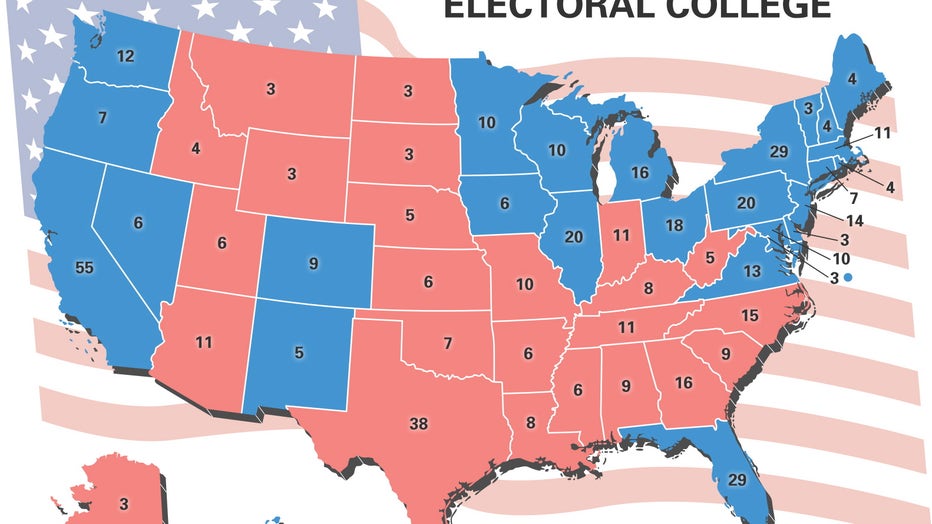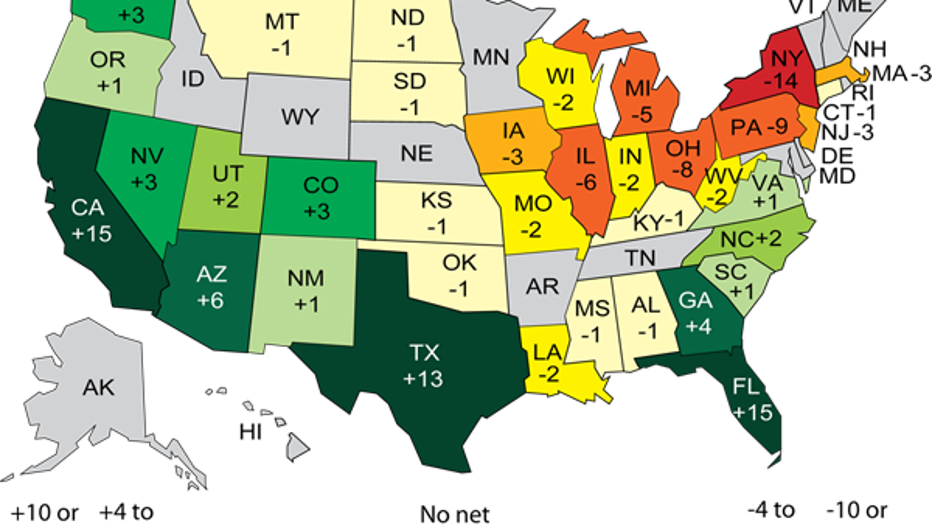Electoral College: How the states stack up in terms of representation
LOS ANGELES - The Electoral College is a uniquely American institution that continues to stir up debate about whether it’s a fair process.
In 2016, Hillary Clinton won the country’s popular vote by more than 2 million votes, yet still lost the Electoral College.
In fact, it became the largest popular vote lead in presidential history for a candidate who would lose the Electoral College and ultimately the title of president of the United States.
It’s what is known as a misfire election, and 2016 wasn’t the first time in American history that it has happened.
Misfire elections have occurred five times in presidential history, and twice in the past five presidential elections.
In 2000, Al Gore got 48.4% of the popular vote to 47.9% for George W. Bush (a margin of about 500,000 votes), yet Bush was declared the winner with 271 votes in the Electoral College.
“There are some studies that have been done in the past that suggest it could happen more frequently in the future due to some demographic changes in the electorate,” Robert Alexander, a political science professor at Ohio Northern University and author of “Representation and the Electoral College,” said.
Understanding electoral representation in the United States
The United States has a total of 538 electoral votes up for grabs.
State’s electoral votes are equal to the number of representatives and senators the state has in Congress. Each state is guaranteed at least one seat in the House and two in the Senate.
According to USAfacts.org, if electoral votes were distributed according to population, one electoral vote would represent about 607,000 people, but this is not the case.
The goal of the Electoral College is to guarantee that densely populated states such as New York, Texas and California cannot dominate the election — but it also causes a disparity.
“While California has one electoral vote per 712,000 people, Wyoming — the least populous state in the country — has one electoral vote per 195,000 people,” the Washington Post reported.

United States electoral college map showing number of electoral votes by state. (Getty Images)
Currently, there are many states that are over-represented, including Wyoming, Vermont and the District of Columbia.
The four most under-represented states are California, followed by New York, Texas and Florida — the country’s most populous states.
If electoral vote shares were equal to population shares in every state
Even if electoral votes were allocated exactly according to each state’s share of the U.S. population or share of eligible voters, the electoral process would still not resemble a national popular vote.
Generally, most states are winner-take-all, meaning that the winner of the state in an election gets all the Electoral College votes.
RELATED: Presidential debates: The history of the American political tradition
“This explains how a candidate may win the national popular vote but, by failing to earn 270 electoral votes, may still lose the presidential election in the Electoral College—a scenario which has occurred in five U.S. presidential elections, including the most recent election in 2016,” USA Facts said.
For example, in Texas there are 38 electoral votes. If Trump wins the state by one vote, he still gets all 38 of the state’s electoral votes.

Voter turnout in 2016 presidential election
“So, it doesn’t truly reflect what happens in the state,” Alexander said. “This is another way we can get a discrepancy between the popular vote and the electoral vote.”
But two states, Maine and Nebraska, have two different systems put into place, which gives two electoral votes to the state’s popular vote winner and one to the winner of the state’s congressional districts.
District representation means awarding an electoral vote based on winning a congressional district, and the rules dictated by both states can affect election outcomes.
RELATED: 2020 presidential election: Where Trump and Biden stand on key issues, according to their campaigns
In fact, in 2016, Trump won one congressional district in Maine, while in 2008, Barack Obama won one congressional district in Nebraska, which is why heavy campaigning happens in Nebraska and Maine from both sides of the aisle, among both Democrats and Republicans.
District representation could have more bearing on the presidential election, but right now only two states utilize it.
Some states have discussed moving toward a district vote style, which would likely transform swing states into swing districts.
Electoral College is based on population, but only a small fraction actually votes
While the Electoral College is based on population, only a small portion of the country actually casts a vote.
According to MIT election data, “states with the highest turnout rates in presidential elections tend to be in the north, while states with lower turnout rates tend to be in the south.”
In Texas, the population is underrepresented in the Electoral College, but is over-represented in votes cast. For example, in 2016, the state’s voting-eligible population was the lowest in the nation, yet Texas still had the second-highest amount of electoral votes.
Alexander said the situation is an example of why Democrats focus efforts on promoting voter turnout in certain states where there is a large liberal population with a lot of electoral votes up for grabs. Meanwhile, you may have Republicans working to suppress the votes in that particular state.
“It gives a lot of power and influence to each state,” Alexander said.
How representation continue to change
Between 1960 (when the first census included Alaska and Hawaii as states) and 2010, there have been large shifts in the number of congressional seats in each state, especially in the South and West.
Fourteen states have seen an increase in their representation in the House. States with the biggest gains included California, Florida and Texas.

Congressional reapportionment changes, 1960-2010
“Both California and Florida have seen their seat totals increase by 15, while Texas saw an increase of 13 seats in this timespan,” the Center for Politics said.
Meanwhile, other states have experienced a decrease in the number of House seats. In fact, New York had 41 seats in 1960 but just 27 in 2010, which is a loss of 14 seats within 50 years.
The census will continue to change representation
House seats are based on the population and are reapportioned every decade after the Census. For example, Arizona is on track to gain two after the 2020 election, while California is on track to lose a congressional seat.
RELATED: USPS launches website providing resources and information on mail-in ballots ahead of 2020 election
Representation will continue to change over time and can continue to impact the election process.
According to Alexander, 20% of all elections have been decided by just 10,000 votes, suggesting that even the smallest of changes to the process could greatly impact the outcome.



